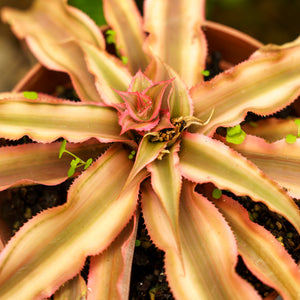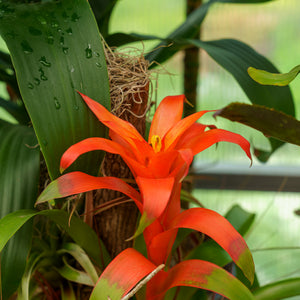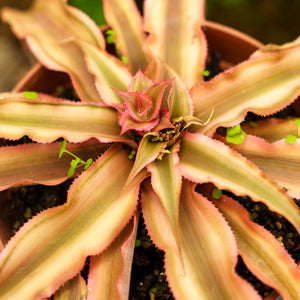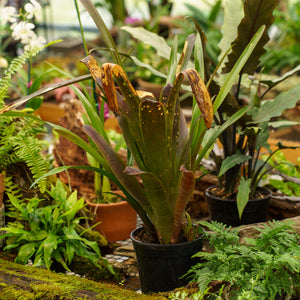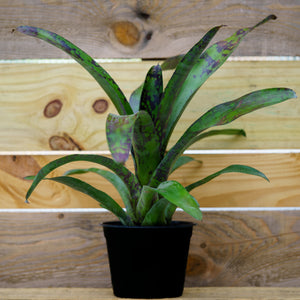The Bromeliad Guide
Bromeliads, with their striking foliage and exotic flowers, bring a touch of the tropics to any garden or indoor space. Known for their vibrant colors and unique shapes, bromeliads are perfect for adding an eye-catching focal point to borders, containers, and interior decor. These plants are admired for their rosettes of stiff, often colorful leaves and their long-lasting, dramatic blooms. Whether you're aiming to create a tropical paradise, enhance your indoor plant collection, or add a splash of color to your landscape, bromeliads offer a captivating and versatile solution. With minimal maintenance requirements and adaptability to various environments, bromeliads are a hassle-free addition to any garden or home.
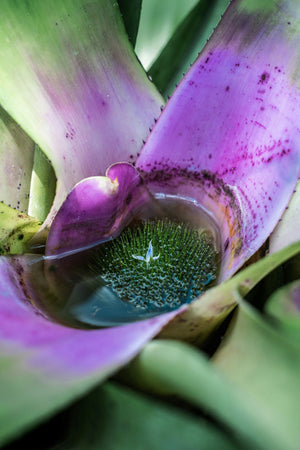
About
Bromeliads belong to the Bromeliaceae family, a diverse group of plants native to the tropical and subtropical regions of the Americas. This family includes over 3,000 species, ranging from small, epiphytic plants that grow on trees to large, terrestrial species that thrive on the forest floor. The most well-known bromeliad is the pineapple (Ananas comosus), but the family also includes many ornamental species prized for their striking appearance.
Bromeliads are known for their rosettes of stiff, often colorful leaves that can range in color from green and red to yellow, purple, and even striped or spotted patterns. These leaves often form a central cup or tank that collects water, providing the plant with moisture and nutrients. The flowers of bromeliads are equally impressive, with vibrant spikes or clusters that can last for several months. Popular species include Guzmania, Aechmea, and Neoregelia, each contributing unique characteristics and stunning visuals.
Beyond their ornamental beauty, bromeliads are incredibly versatile. They can be grown as epiphytes (attached to trees), terrestrials (in soil), or in containers. Their adaptability to indoor and outdoor conditions makes them a favorite among both novice and experienced gardeners. Additionally, bromeliads contribute to improved indoor air quality, adding both aesthetic and functional value to your space.
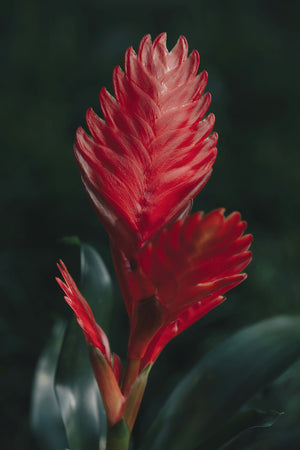
Planting
Proper planting is key to ensuring bromeliads thrive. Follow these guidelines for successful cultivation:
- Soil: Bromeliads prefer a well-draining potting mix. A combination of orchid bark, perlite, and peat moss works well for terrestrial species. Epiphytic bromeliads, which naturally grow on trees, can be mounted on bark or wood or placed in soilless mixes.
- Light: Bright, indirect light is ideal for bromeliads. While they can tolerate lower light levels, vibrant colors and healthy growth are best achieved with adequate light. Avoid direct sunlight, which can scorch leaves.
- Watering: Bromeliads collect water in their central cups. Keep the cups filled with clean, fresh water, and refresh it every 1-2 weeks to prevent stagnation. Lightly water the soil as needed, ensuring it remains moist but not soggy.
- Humidity: High humidity is beneficial for bromeliads, especially indoors. Increase humidity by misting the plants, using a humidifier, or grouping them with other plants.
- Temperature: Bromeliads thrive in temperatures between 60-80°F (16-27°C). While they can tolerate brief temperature drops, protect them from frost or prolonged cold.
- Spacing: When planting multiple bromeliads, allow adequate space for air circulation to minimize the risk of fungal diseases.
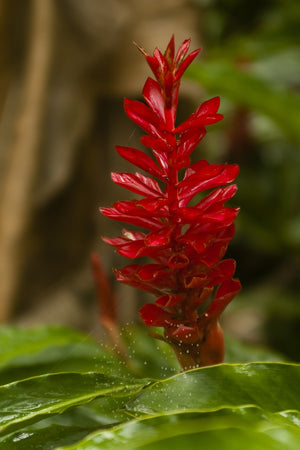
Care
Maintaining bromeliads is straightforward, but proper care ensures optimal growth and long-lasting beauty:
- Watering: Regularly refresh the water in the central cup and water the soil lightly. Allow the soil to dry slightly between waterings to prevent root rot. Use rainwater or distilled water to avoid mineral buildup.
- Fertilizing: Apply a diluted, balanced, water-soluble fertilizer to the soil or cup every 1-2 months during the growing season. Avoid over-fertilizing, as this can damage the plant.
- Pruning: Remove dead or damaged leaves to maintain a neat appearance. After flowering, the bloom will fade and can be trimmed back to encourage new growth and pups.
- Pests and Diseases: Inspect plants regularly for pests such as mealybugs or scale. Treat infestations with insecticidal soap or neem oil. Good air circulation and proper watering help prevent fungal diseases.
- Propagation: Bromeliads produce offsets or “pups” after flowering. Once the pups reach about one-third the size of the parent plant, they can be carefully separated and potted individually.
- Repotting: Bromeliads rarely require repotting, but you can refresh the potting mix or upgrade to a larger container if needed. Ensure the new pot has proper drainage.
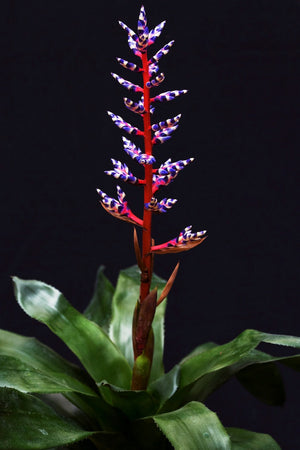
How To Use
Bromeliads bring versatility and tropical charm to any setting. Here’s how you can use them:
- Indoor Decor: Place bromeliads in decorative pots to brighten up living rooms, kitchens, or offices. Their vibrant foliage and flowers create a focal point in any indoor space.
- Terrariums: Small bromeliads are ideal for terrariums, thriving in the humid, enclosed environment. Combine them with moss and other tropical plants for a lush display.
- Container Gardens: Use bromeliads in container arrangements to add height, texture, and color. Mix different species and varieties for dynamic displays on patios or balconies.
- Epiphytic Displays: Mount bromeliads on bark, wood, or cork for unique vertical displays. These can be hung on walls or used as tabletop decor.
- Tropical Gardens: Incorporate bromeliads into outdoor tropical landscapes alongside orchids, ferns, and palms. Their bold colors and forms add depth and interest.
- Borders and Ground Covers: Use low-growing bromeliads as ground covers in shaded garden beds. Their dense rosettes suppress weeds and retain soil moisture.
- Water Features: Position bromeliads near ponds or fountains to enhance the tropical ambiance. Their love of humidity makes them perfect companions for water features.
Conclusion
Bromeliads are a captivating addition to any garden or indoor space. Their vibrant colors, unique shapes, and minimal maintenance requirements make them a favorite among plant enthusiasts. Whether used as eye-catching decor, part of a lush tropical garden, or in creative container arrangements, bromeliads provide year-round beauty and interest.
By following proper planting and care techniques, you can enjoy their exotic charm for years to come. Explore the diverse varieties and creative possibilities that bromeliads offer, and transform your home or garden into a vibrant, tropical paradise.

